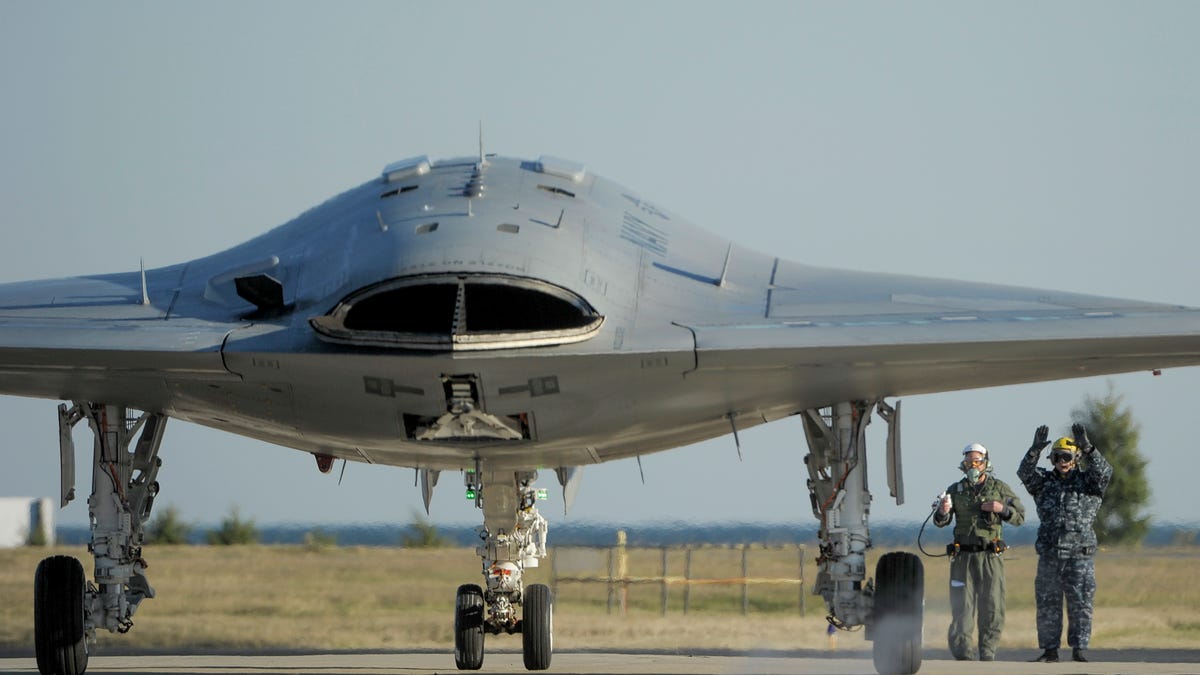Carrier-bound X-47B drone passes remote-control test
On dry land, Northrop Grumman and the U.S. Navy show that they can use a handheld controller to maneuver the drone as if around the tight quarters of an aircraft carrier.

How do you drive a jet-powered drone around the deck of an aircraft carrier? If you've ever guided a remote-control toy car around your kitchen floor, you'll have an idea.
Northrop Grumman said today that it has done its first shore-based tests of a wireless handheld controller that can steer its X-47B unmanned aerial vehicle, a key step toward getting the UAV ready for flight tests on an aircraft carrier in 2013.
In the trial run, which took place earlier this month, Northrop Grumman and the U.S. Navy used the project's Control Display Unit to roll the X-47B forward and to stop it, to execute tight turns, to maneuver it into a catapult and out of a landing area, and to control engine thrust. The overriding goal is to be able to scoot the drone -- also known as the Unmanned Combat Air System demonstrator -- safely around the crowded confines of the carrier's flight deck, without disrupting its normal, busy rhythms.
"Instead of towing the aircraft out to the flight line, we can now start the X-47B outside its hangar, then use the CDU to taxi it out to the runway, or into a catapult for launch," Daryl Martis, Northrop Grumman's UCAS-D test director, said in a statement. "Use of the CDU is the most time-efficient way to move the X-47B into the catapult or disengage it from the arresting gear after landing."
The wingspan of the tailless X-47B is 62 feet -- and just half of that if the wings are folded up for storage on a carrier -- and the length is 38 feet front to back, with twin internal weapons bays. The aircraft is designed to fly up to about 40,000 feet, with a range of 2,100 nautical miles. Northrop Grumman refers to it as "strike fighter-sized," which may give you a sense of the drone's eventual mission.
The X-47B will get a catapult tryout on dry land later this month, and sometime after that it will be lifted aboard an actual carrier, where the CDU will get a more real-life flight deck runaround.
The Navy and Northrop Grumman have a pair of X-47B prototype aircraft, now based in Maryland at Naval Air Station Patuxent River, that they've been putting through the early paces for a couple of years now. The UCAS project aims to achieve two firsts: autonomous carrier-based operations for a jet-powered unmanned aircraft, and autonomous aerial refueling (the latter planned for 2014).
The first-ever flight of an X-47B took place in early February 2011 at Edwards Air Force Base in California.
Update November 16 at 6:50 a.m. PT: For those of you wondering why the photos show a gent apparently giving hand signals to the drone, Northrop Grumman explains his presence this way -- it is an intentional redundancy:
In practice, a deck operator will work in tandem with the flight deck director - aka a "yellow shirt" - to move the X-47B via the CDU to a designated flight deck location. Standing in front of the aircraft, the director will use traditional hand signals to indicate how, when and where the aircraft should move, the same way he would communicate with a pilot in a manned aircraft. The deck operator will stand behind the director and use the CDU to duplicate the director's instructions as digital commands to the aircraft.
Presumably the "yellow shirt" director is helping to make it clear to everyone else on the flight deck what the remote-controlled X-47B is going to do.
It's possible that someday, even an unmanned drone will understand those traditional hand signals. Researchers at MIT are working on the technology to accomplish that very thing.

